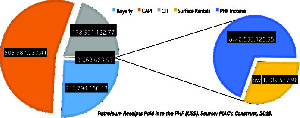 Petroleum Receipts Paid into the PHF (US$)
Petroleum Receipts Paid into the PHF (US$)
Although crude production in 2019 went up 15 percent from 62,135,435.07 barrels in 2018 to 71,439,585 barrels, revenue accrued to the Petroleum Holding Fund (PHF) however dropped by some 5 percent within the same period.
The revenue went down to US$925million in 2019 from US$977million in 2018 from Royalties, Carried and Participating Interest (CAPI), Corporate Income Taxes (CIT), Surface Rentals, and income earned – representing a 5 percent drop, according to the Public Interest and Accountability Committee (PIAC) 2019 annual report.
“The rebound of crude prices that had been experienced in 2018 was reversed in 2019. The average achieved price by Ghana National Petroleum Corporation (GNPC) on behalf of the Ghana Group – US$68.487/bbl in 2018 for all three producing fields – reduced to US$63.496/bbl, which was also below government’s 2019 estimated benchmark price of US$66.670/bbl,” it said.
The drop in revenue despite the increased production was due to lower prices. While government had benchmarked crude to sell at US$66.670/bbl last year, the average achieved price by the country was US$63.496/bbl.
increase in crude production and, more importantly, significant increases (at least a parcel higher) in liftings on all three fields. The decline in revenue, therefore, was occasioned by a drop in prices during the period.
“The average achieved price by GNPC on behalf of the Ghana Group for all three producing fields – Jubilee, TEN and the Sankofa Gye-Nyame (SGN) – at US$63.496/bbl was lower than both the 2018 average (US$68.487/bbl) and government’s 2019 estimated benchmark price (US$66.670/bbl),” the report added.
Breakdown of production
Production of crude oil continues to be derived from three producing fields – Jubilee, TEN and the Sankofa Gye-Nyame (SGN) Fields.
For the year 2019, a total of 71,439,585 barrels (bbls) were obtained from the three producing fields – exceeding the 2018 figure of 62,135,435.07 bbls by 15 percent. It also exceeded the benchmark crude oil output of 63.4 million bbls. The high-recorded volume is on account of increased production on the Jubilee and SGN Fields, with SGN witnessing the highest growth in volumes, followed by Jubilee.
Of the total output, the Jubilee Field produced 31,915,377 bbls compared with a 2018 volume of 28,461,755 bbls; the TEN Field 22,319,137 bbls in comparison with 23,557,361 bbls in 2018; and the SGN Field, 17,205,070.85 bbls relative to 10,751,671 bbls in 2018.
The high production was achieved despite challenges faced by the country’s largest producer, Tullow Ghana, after the firm was forced to cut down production last year.
- Decline in oil production threatens survival of oil companies in Ghana – PIAC warns
- Declining crude production threatens GNPC's Voltaian basin plans
- ‘Create stand-alone gender policy in petroleum value chain’ - Participants
- Ghana's extractive sector: 2023 in focus
- Angola quits OPEC amid dispute over oil production quotas
- Read all related articles
